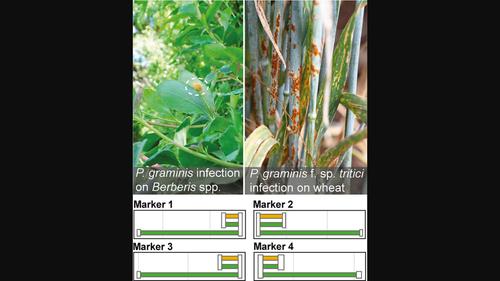比较基因组学确定了与结构变异有关的遗传标记,这些结构变异可区分三联禾谷粉虱和特异禾谷粉虱
IF 2.4
3区 农林科学
Q1 AGRONOMY
引用次数: 0
摘要
茎锈病是许多禾本科植物的一种严重病害,包括小麦、大麦、黑麦和三粒小麦等主粮。病原真菌禾谷粉孢菌(Puccinia graminis)的特化型(ff. spp.)主要感染某些寄主植物属。然而,尽管有这些分类学上的细分,许多禾谷类真菌ff.属在遗传学上过于相似,无法用现有的遗传标记加以区分。对于感染谷物的禾谷镰刀菌(P. graminis f. sp. tritici,Pgt)和矛孢禾谷镰刀菌(P. graminis f. sp. secalis,Pgs)来说,这尤其具有挑战性。在此,我们利用新近获得的 39 株 Pgt 和 Pgs 分离物的基因组数据,确定了四个结构变异区域,并利用这些区域设计了四种基于 PCR 的简单检测方法来区分上述特殊形态。这些基因组区域在 Pgt 和 Pgs 分离物之间显示出较大的存在/不存在差异,但在共享的邻近区域内序列保存程度较高,有利于引物设计。我们还证实在所分析的寄主植物属中缺乏扩增,其中包括对 Pgt 和 Pgs 的共同交替寄主小檗的评估。对小檗上的禾谷粉虱 ff. spp.感染进行准确分类,对于快速确定邻近谷类作物的禾谷粉虱接种体携带植物非常有价值。最后,我们证明了这四种遗传标记在正确区分基因多样的 Pgt 和 Pgs 分离物方面的效用。这一策略现在可随时应用于其他感兴趣的病原体,随着基因组资源的不断迅速扩大,这一策略的价值也将与日俱增。本文章由计算机程序翻译,如有差异,请以英文原文为准。

Comparative genomics identifies genetic markers linked to structural variations that differentiate Puccinia graminis tritici and secalis formae speciales
Stem rust is a serious disease of many gramineous plants including small grain staples such as wheat, barley, rye and triticale. Separate formae speciales (ff. spp.) of the causal fungus, Puccinia graminis , predominantly infect certain host plant genera. However, despite these taxonomic subdivisions, many P . graminis ff. spp. are genetically too similar to distinguish using existing genetic markers. For those infecting cereals, this is particularly challenging for P . graminis f. sp. tritici (Pgt) and P . graminis f. sp. secalis (Pgs). Herein we harnessed newly available genomic data for 39 Pgt and Pgs isolates and identified four regions of structural variation that were used to design four simple PCR‐based assays to distinguish the aforementioned formae speciales . These genomic regions display large presence/absence variation between Pgt and Pgs isolates, and yet a high degree of sequence conservation within shared neighbouring regions, facilitating primer design. We also confirmed lack of amplification in host plant genera analysed, which included assessment of the shared alternate host of Pgt and Pgs, Berberis vulgaris . Accurate classification of P . graminis ff. spp. infections on B . vulgaris is exceptionally valuable to rapidly define plants harbouring P . graminis inoculum when adjacent to cereal crops. Finally, we demonstrated utility of these four genetic markers to correctly distinguish a genetically diverse array of Pgt and Pgs isolates. This strategy could now be readily applied to other pathogens of interest, which will be of increasing value as genomic resources continue to rapidly expand for many key biotic threats to agricultural productivity.
求助全文
通过发布文献求助,成功后即可免费获取论文全文。
去求助
来源期刊

Plant Pathology
生物-农艺学
CiteScore
5.60
自引率
7.40%
发文量
147
审稿时长
3 months
期刊介绍:
This international journal, owned and edited by the British Society for Plant Pathology, covers all aspects of plant pathology and reaches subscribers in 80 countries. Top quality original research papers and critical reviews from around the world cover: diseases of temperate and tropical plants caused by fungi, bacteria, viruses, phytoplasmas and nematodes; physiological, biochemical, molecular, ecological, genetic and economic aspects of plant pathology; disease epidemiology and modelling; disease appraisal and crop loss assessment; and plant disease control and disease-related crop management.
 求助内容:
求助内容: 应助结果提醒方式:
应助结果提醒方式:


